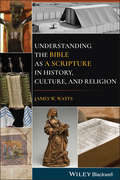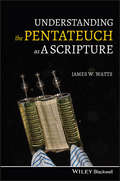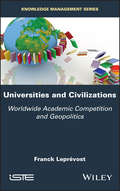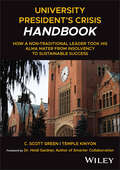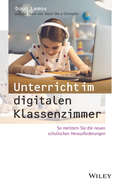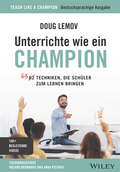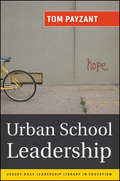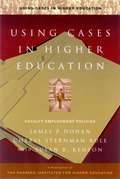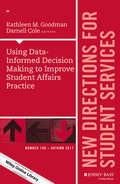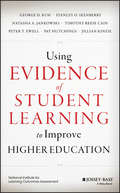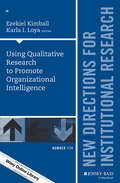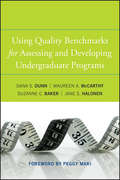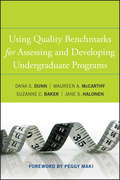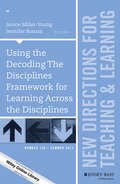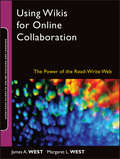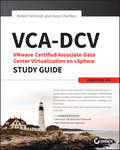- Table View
- List View
Understanding the Bible as a Scripture in History, Culture, and Religion
by James W. WattsUNDERSTANDING THE BIBLE AS A SCRIPTURE IN HISTORY, CULTURE, AND RELIGION The Bible is a popular subject of study and research, yet biblical studies gives little attention to the reason for its popularity: its religious role as a scripture. Understanding the Bible as a Scripture in History, Culture, and Religion integrates the history of the religious interpretation and ritual uses of biblical books into a survey of their rhetoric, composition, and theology in their ancient contexts. Emphasizing insights from comparative studies of different religious scriptures, it combines discussion of the Bible’s origins with its cultural history into a coherent understanding of its past and present function as a scripture.A prominent expert on biblical rhetoric and the ritualization of books, James W. Watts describes how Jews and Christians ritualize the Bible by interpreting it, by expressing it in recitations, music, art, and film, and by venerating the physical scroll and book. The first two sections of the book are organized around the Torah and the Gospels—which have been the focus of Jewish and Christian ritualization of scriptures from ancient to modern times—and treat the history of other biblical books in relation to these two central blocks of the Hebrew Bible and New Testament. In addition to analyzing the semantic contents of all the Bible’s books as persuasive rhetoric, Watts describes their ritualization in the iconic and expressive dimensions in the centuries since they began to function as a scripture, as well as in their origins in ancient Judaism and Christianity. The third section on the cultural history and scriptural function of modern bibles concludes by discussing their influence today and the controversies they have fueled about history, science, race, and gender. Innovative and insightful, Understanding the Bible as a Scripture in History, Culture, and Religion is a groundbreaking introduction to the study of the Bible as a scripture, and an ideal textbook for courses in biblical studies and comparative scripture studies.
Understanding the Pentateuch as a Scripture
by James W. WattsA cutting-edge scholarly review of how the Pentateuch functions as a scripture, and how it came to be ritualized in this way. Understanding the Pentateuch as a Scripture is a unique account of the first five books of the Bible, describing how Jews and Christians ritualize the Pentateuch as a scripture by interpreting it, by performing its text and contents, and by venerating the physical scroll and book. Pentateuchal studies are known for intense focus on questions of how and when the first five books of the Bible were composed, edited, and canonized as scripture. Rather than such purely historical, literary, or theological approaches, Hebrew Bible scholar James W. Watts organizes this description of the Pentateuch from the perspectives of comparative scriptures and religious studies. He describes how the Pentateuch has been used in the centuries since it began to function as a scripture in the time of Ezra, and the origins of its ritualization before that time. The book: Analyzes the semantic contents of the Pentateuch as oral rhetoric that takes the form of stories followed by lists of laws and sanctions Gives equal space to its ritualization in the iconic and performative dimensions as to its semantic interpretation Fully integrates the cultural history of the Pentateuch and Bible with its influence on Jewish and Christian ritual, and in art, music, theatre, and film Understanding the Pentateuch as a Scripture is a groundbreaking work that highlights new research data and organizes the material to focus attention on the Pentateuch’s—and Bible’s— function as a scripture.
Understanding the Pentateuch as a Scripture
by James W. WattsA cutting-edge scholarly review of how the Pentateuch functions as a scripture, and how it came to be ritualized in this way. Understanding the Pentateuch as a Scripture is a unique account of the first five books of the Bible, describing how Jews and Christians ritualize the Pentateuch as a scripture by interpreting it, by performing its text and contents, and by venerating the physical scroll and book. Pentateuchal studies are known for intense focus on questions of how and when the first five books of the Bible were composed, edited, and canonized as scripture. Rather than such purely historical, literary, or theological approaches, Hebrew Bible scholar James W. Watts organizes this description of the Pentateuch from the perspectives of comparative scriptures and religious studies. He describes how the Pentateuch has been used in the centuries since it began to function as a scripture in the time of Ezra, and the origins of its ritualization before that time. The book: Analyzes the semantic contents of the Pentateuch as oral rhetoric that takes the form of stories followed by lists of laws and sanctions Gives equal space to its ritualization in the iconic and performative dimensions as to its semantic interpretation Fully integrates the cultural history of the Pentateuch and Bible with its influence on Jewish and Christian ritual, and in art, music, theatre, and film Understanding the Pentateuch as a Scripture is a groundbreaking work that highlights new research data and organizes the material to focus attention on the Pentateuch’s—and Bible’s— function as a scripture.
Universities and Civilizations: Worldwide Academic Competition and Geopolitics
by Franck LeprevostSince the publication of the first Shanghai ranking in 2003, the international rankings of universities have become evermore important. This book examines the evolution of higher education systems and the role of universities in contemporary societies, which are marked by increased competition and tensions. Investigating whether the dynamism of large universities is an accurate indicator of the intellectual life of their civilizations, Universities and Civilizations systematically analyzes the evolution of universities in several main rankings, from their creation until now. This analysis shows the rise of universities in China and parts of Europe, the decline of American and Japanese universities and the scant presence of universities in Russia, India, Africa and Latin America. This book suggests an overhaul of traditional models of academic cooperation and exchange in an era of growing international tensions and a time when people and knowledge are increasingly mobile.
Universities and Civilizations: Worldwide Academic Competition and Geopolitics
by Franck LeprevostSince the publication of the first Shanghai ranking in 2003, the international rankings of universities have become evermore important. This book examines the evolution of higher education systems and the role of universities in contemporary societies, which are marked by increased competition and tensions. Investigating whether the dynamism of large universities is an accurate indicator of the intellectual life of their civilizations, Universities and Civilizations systematically analyzes the evolution of universities in several main rankings, from their creation until now. This analysis shows the rise of universities in China and parts of Europe, the decline of American and Japanese universities and the scant presence of universities in Russia, India, Africa and Latin America. This book suggests an overhaul of traditional models of academic cooperation and exchange in an era of growing international tensions and a time when people and knowledge are increasingly mobile.
University President's Crisis Handbook: How a Non-Traditional Leader Took His Alma Mater from Insolvency to Sustainable Success
by Scott Green Temple KinyonDiscover the non-traditional leadership techniques that took the University of Idaho from insolvency to international renown In University President’s Crisis Handbook, the President of the University of Idaho, C. Scott Green, and author Temple Kinyon deliver a one-of-a-kind perspective on managing universities through periods of intense turmoil and difficulty. The book offers in-depth managerial insights into the three strategic pillars and industry expert guidance that helped Green shepherd the University of Idaho through years of deep deficits and the COVID-19 pandemic. You’ll find comprehensive discussions of how the university achieved financial solvency, soaring enrollments, record research awards, and record fundraising amid extraordinary challenges. You’ll also discover: Explorations of the strategic touchstones leading to U of I’s transformation: student success, pursuit of R1 Carnegie research classification leading to soaring grant awards, and narrative control How the university and its community supported itself in the face of a tragic and outrageous crime against 4 of its students The strategies used by the university and its faculty to safely reopen the school after lengthy closures in the middle of the COVID-19 pandemic Perfect for university administrators, University President’s Crisis Handbook will also prove invaluable to academics with leadership responsibilities and managers, executives, board members and other leaders in the public and private sectors.
University President's Crisis Handbook: How a Non-Traditional Leader Took His Alma Mater from Insolvency to Sustainable Success
by Scott Green Temple KinyonDiscover the non-traditional leadership techniques that took the University of Idaho from insolvency to international renown In University President’s Crisis Handbook, the President of the University of Idaho, C. Scott Green, and author Temple Kinyon deliver a one-of-a-kind perspective on managing universities through periods of intense turmoil and difficulty. The book offers in-depth managerial insights into the three strategic pillars and industry expert guidance that helped Green shepherd the University of Idaho through years of deep deficits and the COVID-19 pandemic. You’ll find comprehensive discussions of how the university achieved financial solvency, soaring enrollments, record research awards, and record fundraising amid extraordinary challenges. You’ll also discover: Explorations of the strategic touchstones leading to U of I’s transformation: student success, pursuit of R1 Carnegie research classification leading to soaring grant awards, and narrative control How the university and its community supported itself in the face of a tragic and outrageous crime against 4 of its students The strategies used by the university and its faculty to safely reopen the school after lengthy closures in the middle of the COVID-19 pandemic Perfect for university administrators, University President’s Crisis Handbook will also prove invaluable to academics with leadership responsibilities and managers, executives, board members and other leaders in the public and private sectors.
Unterricht im digitalen Klassenzimmer: So meistern Sie die neuen schulischen Herausforderungen
by Doug LemovSchulschließungen als Reaktion auf Covid-19 stellen eine beispiellose Bedrohung für die Bildung von Kindern dar. Bereits der erste Lockdown hat zu einem Wendepunkt hin zum Online-, bzw. Hybridunterricht geführt. Es besteht ein neuer Bedarf nach Hilfestellungen, mit denen die sonst persönlich anwesenden Pädagogen beim erfolgreichen Übergang zu einem engagierten Online-Unterricht für ihre Schüler unterstützt werden können. "Unterricht im digitalen Klassenzimmer" geht auf die Herausforderungen ein, die sich im Bildungswesen durch die Coronavirus-Pandemie ergeben haben. Doug Lemov und sein Team leiten Pädagogen mit Hilfe von in der Praxis gewährten Techniken an, Schüler erfolgreich im Online-Unterricht zu engagieren. Ziel des Buches ist es, zeitgemäße, einfach zu implementierende Strategien für Tausende von Pädagogen bereitzustellen, die gezwungen waren (und sind), sich auf den Online-Unterricht umzustellen. Behandelt werden Themen wie die Entwicklung von Online-Klassenkulturen, die Bekämpfung von Online-Ablenkungen, Vorteile und Grenzen des synchronen und asynchronen Lernens, verbale und visuelle Normen und Verfahren sowie die Nutzung von Online-Plattformen zur Maximierung der Lehrmöglichkeiten. Unterstützt werden die Erläuterungen im Buch durch Videos, die den Einsatz in der Praxis zeigen.
Unterrichte wie ein Champion: 63 Techniken, die Schüler zum Lernen bringen. Teach Like a Champion - Deutschsprachige Ausgabe (Für Dummies Ser.)
by Doug LemovIn vielen Klassenzimmern mangelt es am Engagement. Die Forschung zeigt, dass engagierte Schüler weitaus häufiger gute Schulnoten bekommen und weitaus häufiger hoffnungsvoll in die Zukunft blicken. Die besten Pädagogen bemühen sich daher, gut geführte Klassenzimmer zu schaffen, die das Engagement, das Vertrauen, den Respekt, die Verantwortlichkeit und die Konzentration der Schüler fördern. "Unterrichte wie ein Champion" vermittelt wirksame Lehrtechniken, die Lehrenden, vor allem denjenigen in den ersten Jahren, dabei helfen, wahre Champions im Klassenzimmer zu werden. Diese wirkungsvollen Techniken sind konkret, spezifisch und lassen sich leicht und direkt am nächsten Tag in die Tat umsetzen. Trainingsaktivitäten am Ende jedes Kapitels helfen dem Pädagogen, sein Verständnis durch Reflexion und Anwendung der Ideen auf seine eigene Praxis zu vertiefen. In einem "fruchtbaren Zyklus" wurden die Techniken in diesem Buch in fast zehn Jahren weltweit und regelmäßig verbessert. Begleitet wird das Buch durch einen Zugang zu über 100 Videos aus der Praxis, die die praktische Anwendung der Techniken zeigen.
Urban School Leadership (Jossey-Bass Leadership Library in Education #9)
by Tom PayzantThis important book, written by educational expert and urban school leader, Tom Payzant, offers a realistic understanding of what urban school leadership looks like from the inside. Payzant shares his first-hand knowledge of the unique managerial, instructional, and political tasks of this role. Effectively combining practical lessons and research, Urban School Leadership includes in-depth analysis of various leadership concerns. The book covers topics such as improving student achievement, working with unions, building community, and maintaining and developing resources. Most importantly, it offers stories of real school leaders whose successes and missteps reveal the inherent "messiness" of this difficult job. Urban School Leadership is part of the Jossey-Bass Leadership Library in Education series. "This important book provides compelling examples of how effective leaders can have hope, see progress, and achieve success for all children in the schools and districts they lead."—Richard Riley, former United States Secretary of Education "Tom Payzant is one of the few people who could provide such a comprehensive, useful book for educational leaders at all levels. This very practical book is grounded in the important experiences and impressive judgment of one of our nation's most successful school superintendents"—Jon Schnur, co-founder and CEO, New Leaders for New Schools "Tom Payzant is one of the finest urban educators of our generation. Urban School Leadership is compelling, crisp, and wise—providing a clear path for those dedicated to improving the trajectory of children's lives."—Timothy F.C. Knowles, executive director, Center for Urban School Improvement, University of Chicago "Urban School Leadership is a must read for anyone interested in the landscape of urban public education in America."—Beverly Hall, superintendent, Atlanta Public Schools
Urban School Leadership (Jossey-Bass Leadership Library in Education #9)
by Tom PayzantThis important book, written by educational expert and urban school leader, Tom Payzant, offers a realistic understanding of what urban school leadership looks like from the inside. Payzant shares his first-hand knowledge of the unique managerial, instructional, and political tasks of this role. Effectively combining practical lessons and research, Urban School Leadership includes in-depth analysis of various leadership concerns. The book covers topics such as improving student achievement, working with unions, building community, and maintaining and developing resources. Most importantly, it offers stories of real school leaders whose successes and missteps reveal the inherent "messiness" of this difficult job. Urban School Leadership is part of the Jossey-Bass Leadership Library in Education series. "This important book provides compelling examples of how effective leaders can have hope, see progress, and achieve success for all children in the schools and districts they lead."—Richard Riley, former United States Secretary of Education "Tom Payzant is one of the few people who could provide such a comprehensive, useful book for educational leaders at all levels. This very practical book is grounded in the important experiences and impressive judgment of one of our nation's most successful school superintendents"—Jon Schnur, co-founder and CEO, New Leaders for New Schools "Tom Payzant is one of the finest urban educators of our generation. Urban School Leadership is compelling, crisp, and wise—providing a clear path for those dedicated to improving the trajectory of children's lives."—Timothy F.C. Knowles, executive director, Center for Urban School Improvement, University of Chicago "Urban School Leadership is a must read for anyone interested in the landscape of urban public education in America."—Beverly Hall, superintendent, Atlanta Public Schools
Using Cases in Higher Education: A Guide for Faculty and Administrators
by James P. Honan Cheryl Sternman RuleUsing Cases in Higher Education: A Guide for Faculty and Administrators is an essential resource created for faculty and administrators who utilize case studies to analyze, assess, and respond to the complex and difficult issues facing higher education leaders. While this volume will prove useful with any case study, it is specifically designed to complement the series of casebooks and teaching notes, starting with Casebook I: Faculty Employment Policies and Teaching Notes to Casebook I: Faculty Employment Policies.
Using Data-Informed Decision Making to Improve Student Affairs Practice: New Directions for Student Services, Number 159 (J-B SS Single Issue Student Services)
by Kathleen M. Goodman Darnell ColeIs the data available on your college campus fully utilized? Analyzing data does not have to be a complex process, but there can be obstacles to putting data to good use: overworked staff or understaffed departments; silos that prevent crossing institutional boundaries; lack of research training; or simply being overwhelmed by the possibilities. Addressing these obstacles, this volume presents pragmatic ideas for implementing data-informed decision making to improve student affairs practice. It first illustrates how to easily analyze quantitative data and read assessment reports—demonstrating that advanced research knowledge is not necessary to make meaning of survey findings. It then provides suggestions for utilizing findings from large data sets typically available on campus and gives practical guidance for making sense of and using quantitative data to inform practice. Also included is how to use data to understand the experiences of non-dominant populations on campus, which is especially relevant given the diversity of today's college students. Several chapters speak directly to using data to understand marginalized groups based on race, religion, and sexual orientation, while others focus on using data to understand campus diversity experiences. This is the 159th volume of this Jossey-Bass higher education quarterly series. An indispensable resource for vice presidents of student affairs, deans of students, student counselors, and other student services professionals, New Directions for Student Services offers guidelines and programs for aiding students in their total development: emotional, social, physical, and intellectual.
Using Data-Informed Decision Making to Improve Student Affairs Practice: New Directions for Student Services, Number 159 (J-B SS Single Issue Student Services)
by Ss Kathleen M. Goodman Darnell ColeIs the data available on your college campus fully utilized? Analyzing data does not have to be a complex process, but there can be obstacles to putting data to good use: overworked staff or understaffed departments; silos that prevent crossing institutional boundaries; lack of research training; or simply being overwhelmed by the possibilities. Addressing these obstacles, this volume presents pragmatic ideas for implementing data-informed decision making to improve student affairs practice. It first illustrates how to easily analyze quantitative data and read assessment reports—demonstrating that advanced research knowledge is not necessary to make meaning of survey findings. It then provides suggestions for utilizing findings from large data sets typically available on campus and gives practical guidance for making sense of and using quantitative data to inform practice. Also included is how to use data to understand the experiences of non-dominant populations on campus, which is especially relevant given the diversity of today's college students. Several chapters speak directly to using data to understand marginalized groups based on race, religion, and sexual orientation, while others focus on using data to understand campus diversity experiences. This is the 159th volume of this Jossey-Bass higher education quarterly series. An indispensable resource for vice presidents of student affairs, deans of students, student counselors, and other student services professionals, New Directions for Student Services offers guidelines and programs for aiding students in their total development: emotional, social, physical, and intellectual.
Using Evidence of Student Learning to Improve Higher Education
by George D. Kuh Stanley O. Ikenberry Natasha A. Jankowski Timothy Reese Cain Ewell Pat Hutchings Jillian KinzieAmerican higher education needs a major reframing of student learning outcomes assessment Dynamic changes are underway in American higher education. New providers, emerging technologies, cost concerns, student debt, and nagging doubts about quality all call out the need for institutions to show evidence of student learning. From scholars at the National Institute for Learning Outcomes Assessment (NILOA), Using Evidence of Student Learning to Improve Higher Education presents a reframed conception and approach to student learning outcomes assessment. The authors explain why it is counterproductive to view collecting and using evidence of student accomplishment as primarily a compliance activity. Today's circumstances demand a fresh and more strategic approach to the processes by which evidence about student learning is obtained and used to inform efforts to improve teaching, learning, and decision-making. Whether you're in the classroom, an administrative office, or on an assessment committee, data about what students know and are able to do are critical for guiding changes that are needed in institutional policies and practices to improve student learning and success. Use this book to: Understand how and why student learning outcomes assessment can enhance student accomplishment and increase institutional effectiveness Shift the view of assessment from being externally driven to internally motivated Learn how assessment results can help inform decision-making Use assessment data to manage change and improve student success Gauging student learning is necessary if institutions are to prepare students to meet the 21st century needs of employers and live an economically independent, civically responsible life. For assessment professionals and educational leaders, Using Evidence of Student Learning to Improve Higher Education offers both a compelling rationale and practical advice for making student learning outcomes assessment more effective and efficient.
Using Evidence of Student Learning to Improve Higher Education
by George D. Kuh Stanley O. Ikenberry Natasha A. Jankowski Timothy Reese Cain Ewell Pat Hutchings Jillian KinzieAmerican higher education needs a major reframing of student learning outcomes assessment Dynamic changes are underway in American higher education. New providers, emerging technologies, cost concerns, student debt, and nagging doubts about quality all call out the need for institutions to show evidence of student learning. From scholars at the National Institute for Learning Outcomes Assessment (NILOA), Using Evidence of Student Learning to Improve Higher Education presents a reframed conception and approach to student learning outcomes assessment. The authors explain why it is counterproductive to view collecting and using evidence of student accomplishment as primarily a compliance activity. Today's circumstances demand a fresh and more strategic approach to the processes by which evidence about student learning is obtained and used to inform efforts to improve teaching, learning, and decision-making. Whether you're in the classroom, an administrative office, or on an assessment committee, data about what students know and are able to do are critical for guiding changes that are needed in institutional policies and practices to improve student learning and success. Use this book to: Understand how and why student learning outcomes assessment can enhance student accomplishment and increase institutional effectiveness Shift the view of assessment from being externally driven to internally motivated Learn how assessment results can help inform decision-making Use assessment data to manage change and improve student success Gauging student learning is necessary if institutions are to prepare students to meet the 21st century needs of employers and live an economically independent, civically responsible life. For assessment professionals and educational leaders, Using Evidence of Student Learning to Improve Higher Education offers both a compelling rationale and practical advice for making student learning outcomes assessment more effective and efficient.
Using Qualitative Research to Promote Organizational Intelligence: New Directions for Institutional Research, Number 174 (J-B IR Single Issue Institutional Research)
by Ezekiel Kimball Karla I. LoyaLearn how to use qualitative research as a tool for institutional research. Although institutional researchers often employ informal qualitative methods (their experiences and anecdotal observations), this volume argues that true organizational intelligence is facilitated by formalizing the qualitative data collection and analysis process in institutional research. To that end, it presents a systematic approach to qualitative research in institutional research that connects technical and analytical skills with issues awareness and knowledge of context. Topics covered include: Technical/analytical awareness practices Issues awareness Practices that achieve contextual awareness. This is the 174th volume of this Jossey-Bass quarterly report series. Timely and comprehensive, New Directions for Institutional Research provides planners and administrators in all types of academic institutions with guidelines in such areas as resource coordination, information analysis, program evaluation, and institutional management.
Using Qualitative Research to Promote Organizational Intelligence: New Directions for Institutional Research, Number 174 (J-B IR Single Issue Institutional Research)
by Ezekiel Kimball Karla I. LoyaLearn how to use qualitative research as a tool for institutional research. Although institutional researchers often employ informal qualitative methods (their experiences and anecdotal observations), this volume argues that true organizational intelligence is facilitated by formalizing the qualitative data collection and analysis process in institutional research. To that end, it presents a systematic approach to qualitative research in institutional research that connects technical and analytical skills with issues awareness and knowledge of context. Topics covered include: Technical/analytical awareness practices Issues awareness Practices that achieve contextual awareness. This is the 174th volume of this Jossey-Bass quarterly report series. Timely and comprehensive, New Directions for Institutional Research provides planners and administrators in all types of academic institutions with guidelines in such areas as resource coordination, information analysis, program evaluation, and institutional management.
Using Quality Benchmarks for Assessing and Developing Undergraduate Programs
by Dana S. Dunn Maureen A. McCarthy Suzanne C. Baker Jane S. HalonenPraise for Using Quality Benchmarks for Assessing and Developing Undergraduate Programs "This welcome volume provides discipline-friendly, carefully crafted frameworks for focusing faculty and staff on the dimensions that matter to student learning and institutional effectiveness." —GEORGE D. KUH, Chancellor's Professor and director, Indiana University Center for Postsecondary Research "A welcome contrast to narrow, mechanical views of assessment, this volume provides a comprehensive model for academic program improvement. Readers will find a powerful framework, flexible tools, and a human touch that brings the whole process to life." —PAT HUTCHINGS, former vice president, The Carnegie Foundation for the Advancement of Teaching "Comprehensive in its scope, detailed in its research and analysis, practical in its examples and recommendations, this book provides a refreshingly developmental approach to program assessment and improvement." —TIMOTHY RIORDAN, associate provost, Alverno College
Using Quality Benchmarks for Assessing and Developing Undergraduate Programs
by Dana S. Dunn Maureen A. McCarthy Suzanne C. Baker Jane S. HalonenPraise for Using Quality Benchmarks for Assessing and Developing Undergraduate Programs "This welcome volume provides discipline-friendly, carefully crafted frameworks for focusing faculty and staff on the dimensions that matter to student learning and institutional effectiveness." —GEORGE D. KUH, Chancellor's Professor and director, Indiana University Center for Postsecondary Research "A welcome contrast to narrow, mechanical views of assessment, this volume provides a comprehensive model for academic program improvement. Readers will find a powerful framework, flexible tools, and a human touch that brings the whole process to life." —PAT HUTCHINGS, former vice president, The Carnegie Foundation for the Advancement of Teaching "Comprehensive in its scope, detailed in its research and analysis, practical in its examples and recommendations, this book provides a refreshingly developmental approach to program assessment and improvement." —TIMOTHY RIORDAN, associate provost, Alverno College
Using the Decoding The Disciplines Framework for Learning Across the Disciplines: New Directions for Teaching and Learning, Number 150 (J-B TL Single Issue Teaching and Learning)
by Janice Miller-Young Jennifer BomanDecoding the Disciplines, a program designed to help instructors increase learning in their courses, provides a framework for identifying and remedying course elements that are most problematic for students. Decoding is a seven-step process in which instructors:1. identify a bottleneck of learning, 2. make explicit the mental operations required to overcome the obstacle, 3. model the required steps for students,4. give them practice at these skills, 5. deal with emotional bottlenecks that interfere with learning, 6. assess the success of their efforts, and7. share the results. Providing detailed information so that readers may develop effective models of practice, this volume provides examples and evidence of the ways the framework has been applied across disciplines and used to inform teaching, curriculum, and pedagogical research initiatives. It outlines how various communities of practice got started, describes the analyses of three different collections of Decoding interviews, extends the Decoding framework using different theoretical lenses, and connects the learning to practical applications for teachers and scholars in higher education.This is the 150th volume of this Jossey-Bass higher education series. It offers a comprehensive range of ideas and techniques for improving college teaching based on the experience of seasoned instructors and the latest findings of educational and psychological researchers.
Using the Decoding The Disciplines Framework for Learning Across the Disciplines: New Directions for Teaching and Learning, Number 150 (J-B TL Single Issue Teaching and Learning)
by Jennifer Boman Janice Miller-YoungDecoding the Disciplines, a program designed to help instructors increase learning in their courses, provides a framework for identifying and remedying course elements that are most problematic for students. Decoding is a seven-step process in which instructors:1. identify a bottleneck of learning, 2. make explicit the mental operations required to overcome the obstacle, 3. model the required steps for students,4. give them practice at these skills, 5. deal with emotional bottlenecks that interfere with learning, 6. assess the success of their efforts, and7. share the results. Providing detailed information so that readers may develop effective models of practice, this volume provides examples and evidence of the ways the framework has been applied across disciplines and used to inform teaching, curriculum, and pedagogical research initiatives. It outlines how various communities of practice got started, describes the analyses of three different collections of Decoding interviews, extends the Decoding framework using different theoretical lenses, and connects the learning to practical applications for teachers and scholars in higher education.This is the 150th volume of this Jossey-Bass higher education series. It offers a comprehensive range of ideas and techniques for improving college teaching based on the experience of seasoned instructors and the latest findings of educational and psychological researchers.
Using Wikis for Online Collaboration: The Power of the Read-Write Web (Jossey-Bass Guides to Online Teaching and Learning #15)
by James A. West Margaret L. WestHow can online instructors and course designers' instruction harness the popular Web 2.0 tool, the wiki, for successful collaboration and learning outcomes? This book focuses on using wikis in the active learning processes that are the hallmark of collaborative learning and constructivism. It provides both the pedagogical background and practical guidelines, tools, and processes for accomplishing these goals with special emphasis on wikis and other collaborative design tools. This book supports the effective design and delivery of online courses through the integration of collaborative writing and design activities.
Using Wikis for Online Collaboration: The Power of the Read-Write Web (Jossey-Bass Guides to Online Teaching and Learning #10)
by James A. West Margaret L. WestHow can online instructors and course designers' instruction harness the popular Web 2.0 tool, the wiki, for successful collaboration and learning outcomes? This book focuses on using wikis in the active learning processes that are the hallmark of collaborative learning and constructivism. It provides both the pedagogical background and practical guidelines, tools, and processes for accomplishing these goals with special emphasis on wikis and other collaborative design tools. This book supports the effective design and delivery of online courses through the integration of collaborative writing and design activities.
VCA-DCV VMware Certified Associate on vSphere Study Guide: VCAD-510
by Robert Schmidt Dane CharltonUse this expert guide to prepare for the VCA-DCV exam VCA-DCV VMware Certified Associate on vSphere Study Guide: VCAD-510 is a comprehensive study guide for the VMware Certified Associate – Data Center Virtualization exam. Hands-on examples, real-world scenarios, and expert review questions cover the full exam blueprint, and the companion website offers a suite of tools to help you prepare for the exam including practice exams, electronic flashcards, and a glossary of key terms. In addition, the website includes videos that demonstrate how to complete the more challenging tasks. Focused on practical skills, this study guide not only prepares you for the certification exam, but also for the duties expected of a VCA. The VMware Certified Associate-Data Center Virtualization certification targets those with limited virtualization and VMware data center technology experience, providing a springboard to the popular VMware Certified Professional-Data Center Virtualization certification. Virtualization has become a high priority among organizations, and credentialed professionals are in high demand. This guide helps you prove a certain level of foundational skill in basic virtualization technology, including the vSphere suite's Infrastructure Services, Application Services, and vCenter Server. Topics include: Explaining data center virtualization concepts Identifying the core components of vSphere Networking and storage planning/configuration with vSphere Correlating VMware solutions to common business challenges The VCA-DCV certification is the only one with no instructor-led training requirement, so a thorough study guide is an invaluable tool in you exam preparation. This book not only covers the full exam, but also provides practice designed to actually improve the skills used every day on the job. VCA-DCV VMware Certified Associate on vSphere Study Guide is more than just test prep—it's job prep.
